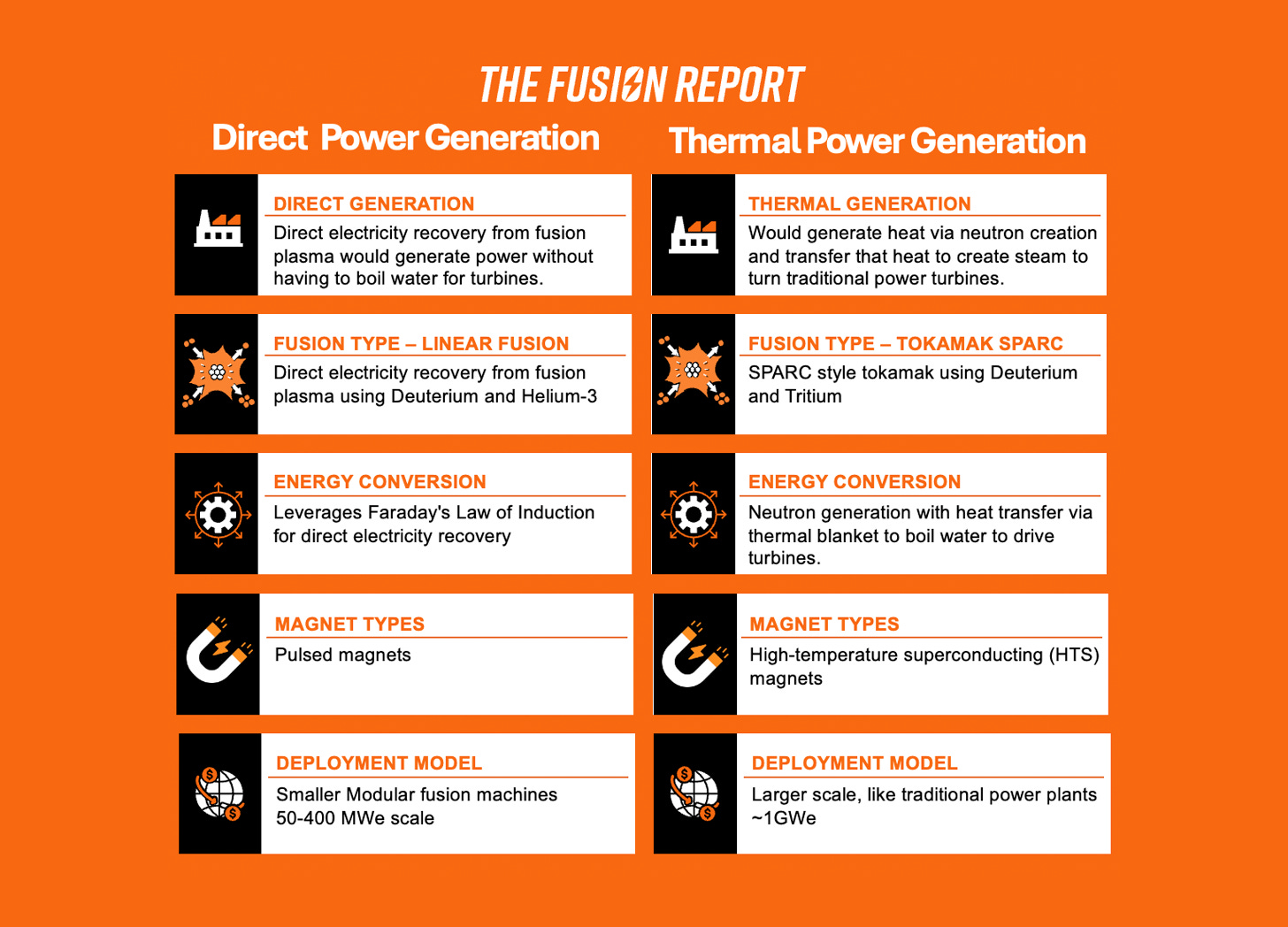For a few minutes, let’s set aside skepticism and choose to believe that our industry has made fusion energy work. For this conversation, we will assume that Helion, CFS, Tokamak, General Fusion, Pacific, Focused, TAE, Zap Energy, and others have achieved their goals and have shippable fusion energy systems. This article will use Helion and CFS as examples to illustrate the points below. In the end, we have two primary options for deploying fusion power generation:
Direct Power Generation - Power generation that does not use traditional water/steam turbine systems to produce electricity.
Fusion Heat Generation - Power generation that does use traditional water/steam turbine systems to produce electricity.
Governments, utilities, cloud/social media giants, and industrial companies are considering deploying fusion machines for power generation. So, what are the impacts on cost, infrastructure, required resources, and power delivery? We will look at three basic deployment options:
New Direct Power - New data center or industrial steel plant
New Power Plant - Power plant for a new region that has a growing demand
Upgrade Power Plant - Upgrading an existing plant to leverage the current footprint
Direct Power Generation Fusion Systems
Helion Energy is best known for its early contracts to deliver fusion machines to Microsoft, Nucor Steel, and its direct driver energy recovery system. The direct drive approach to fusion power generation has the potential to be game-changing. Helion’s system aims to produce electricity directly from fusion reactions, bypassing the need for traditional steam turbines.
Simplified Power Generation Process - Helion's direct power generation system eliminates the need for a water/steam turbine system. This simplification has several advantages:
Reduced complexity in plant design and operation
Lower maintenance requirements
Potentially higher overall system efficiency
Compact Design - Helion's fusion plants could be significantly smaller than traditional power plants without large steam turbines and associated cooling systems. This compact design offers:
Reduced land use requirements
Greater flexibility in plant siting
Potential for modular, scalable power generation
Lower Water Usage - Traditional thermal power plants, including those using steam turbines, require substantial water for cooling. Helion's direct power generation approach could dramatically reduce or eliminate this water requirement, leading to the following:
Reduces demand on water services (vital for arid areas)
Ability to site plants in water-scarce regions
Reduced costs associated with water procurement and treatment
Faster Construction and Deployment - The simplified design of Helion's system could lead to more rapid construction and deployment times compared to traditional power plants. This could result in:
Quicker return on investment
More rapid scaling of fusion power capacity
Increased ability to meet growing energy demands
Potential for Lower Costs - By eliminating the need for steam turbines and associated systems, Helion's approach could lead to significant cost savings:
Reduced capital costs for plant construction
Lower operational and maintenance costs
Potential for cheaper electricity production
Fusion-Powered Thermal Turbine Systems
Bob Mugraurd spoke about upgrading existing brownfield power plants to fusion during the 2024 FIA Policy. He outlined some key benefits of upgrading brownfield power plants at the conference, which are listed below. Commonwealth Fusion Systems and many others are developing fusion machines to replace other thermal sources and leverage existing infrastructure. The company aims to use its fusion machine as a heat source for existing steam turbine systems, similar to how current nuclear fission plants operate.
Compatibility with Existing Infrastructure - by using fusion as a heat source for steam turbines, CFS's approach offers several advantages:
Ability to retrofit existing coal or natural gas plants
Utilization of well-established power generation and distribution systems
Easier integration with the current electrical grid
Proven Power Generation Technology - steam turbine systems are a mature technology that provides benefits such as:
Well-understood operational characteristics
Existing supply chains for components and maintenance
Established regulatory frameworks
Workforce Familiarity - the power industry has extensive experience with steam turbine systems, leading to:
Availability of skilled operators and maintenance personnel
Established training programs and procedures
Easier transition for workers from fossil fuel plants
Potential for Cogeneration—Steam turbine systems allow for cogeneration applications, where waste heat can be used for industrial processes or district heating, potentially increasing overall system efficiency.
Scalability—The steam turbine approach allows for various plant sizes, from small modular reactors to large-scale power plants, providing flexibility in deployment options.
Drivers of Greenfield and Brownfield Fusion Deployments
Tech giants like Google, Amazon, Meta, and Microsoft are driving a significant increase in power demand. This surge is primarily due to the rapid expansion of data centers and the growing energy requirements of artificial intelligence and cloud computing. This surge in energy consumption is creating new opportunities for greenfield and brownfield power projects.
The scale of energy consumption by these tech companies is staggering. For instance, Google alone consumed more than 24 terawatt hours of electricity last year. To meet their ambitious sustainability goals and power their expanding operations, these companies are increasingly turning to renewable energy sources and innovative power solutions. This has led to massive investments in new renewable energy projects, such as Google's deal with Brookfield to purchase over 10.5 gigawatts of clean power between 2026 and 2030.
At the same time, the tech giants are also exploring opportunities to repurpose existing power infrastructure. For example, Microsoft is partnering with Constellation Energy to restart the Three Mile Island nuclear facility. Upgrading brownfield sites offers several advantages, including faster deployment times, lower costs, and the ability to leverage existing grid connections and transmission access. Key criteria for tech companies when considering power projects include:
Carbon-free or low-carbon energy sources to meet sustainability goals
Scalability to accommodate rapidly growing power demands
Reliability and 24/7 availability to ensure uninterrupted data center operations
Proximity to data centers to reduce transmission losses and improve efficiency
Cost-effectiveness to maintain competitive advantage
Ability to integrate with existing grid infrastructure
Potential for innovative technologies, such as small modular reactors or fusion power
Opportunities for behind-the-meter arrangements to improve renewable capacity utilization
Making the Switching to Fusion Thermal Sources
Replacing a coal or natural gas thermal source with a fusion thermal source in an existing power plant would be a complex but potentially transformative process. The main advantage of this approach is that much of the existing infrastructure, such as the steam turbines, generators, cooling systems, and grid connections, could be reused. This would significantly reduce the cost and time required compared to building an entirely new fusion power plant.
The process would involve removing the existing coal or gas boilers and replacing them with a fusion reactor as the heat source. This would require careful planning and engineering to ensure the fusion reactor integrates seamlessly with the existing steam cycle. Depending on the complexity of the project and the readiness of fusion technology, the timeframe for such a conversion could range from 2 to 5 years. In contrast, building a new fusion plant from scratch could take 5 to 10 years, considering site selection, permitting, and construction.
However, several challenges would need to be addressed. The fusion reactor must be designed to produce heat at temperatures compatible with the existing steam cycle. Safety systems and radiation shielding would need to be installed. The control systems would require significant upgrades to manage the fusion process. Additionally, the workforce would need extensive retraining to operate and maintain the fusion equipment. Despite these challenges, the potential benefits of repurposing existing power plant sites for fusion are significant, including preserving local jobs, utilizing existing infrastructure, and accelerating the transition to clean energy.
Comparative Cost Analysis
While exact costs for fusion power are still speculative, we can make educated estimates based on current power generation costs and the potential savings from fusion technology.
According to the U.S. Energy Information Administration (EIA), the levelized cost of electricity (LCOE) for new generation resources entering service in 2026 ranges from $36.61/MWh for combined cycle natural gas to $97.80/MWh for coal with 90% carbon capture and sequestration.
Eliminating steam turbines and associated equipment could reduce capital costs by 20-30% compared to traditional thermal plants for Helion's direct power generation system. Additionally, the simplified system could lead to 15-25% operational cost savings. If these savings translate directly to LCOE, Helion's system could potentially achieve costs of $30-40/MWh.
Commonwealth Fusion Systems' approach, while still using steam turbines, would eliminate fuel costs associated with fossil fuels. The EIA estimates that fuel costs account for about 80% of the operating costs for natural gas plants and 50% for coal plants. Assuming CFS can achieve similar capital costs to current nuclear plants (around $70-80/MWh) and factoring in eliminating fuel costs, their LCOE could fall in the $50-60/MWh range.
It's important to note that these are speculative estimates, and actual costs will depend on many factors, including the success of fusion technology development, economies of scale, and regulatory environments.
The Right Solutions for The Right Applications
Helion Energy and Commonwealth Fusion Systems offer promising approaches to fusion power deployment, each with its own advantages and challenges. Helion's direct power generation system has the potential for greater efficiency, lower costs, and reduced environmental impact but fits ace challenges as a novel technology. CFS's approach offers easier integration with existing infrastructure and industry experience but may have lower overall efficiency and larger environmental footprints.
The success of fusion power deployment will likely depend on technological advancement, cost reduction, and regulatory support. As these companies move closer to commercial deployment, the energy industry will watch closely to see which approach proves more viable in the long term. Regardless of which system ultimately prevails, the advent of fusion power has the potential to revolutionize our energy landscape and play a crucial role in addressing global energy needs and climate challenges.






